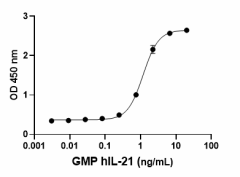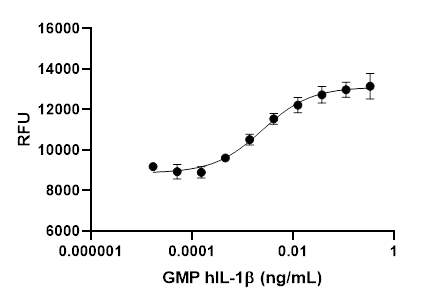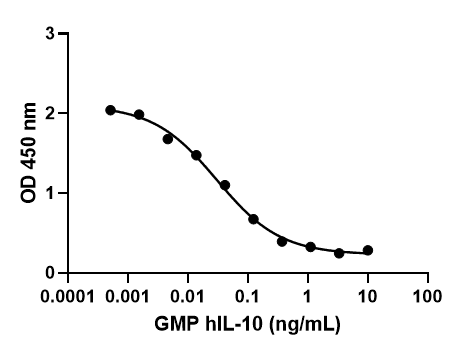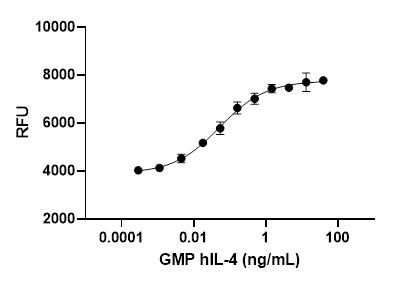- Other Names
- Interleukin 21, Interleukin-21, IL21
- Ave. Rating
- Submit a Review
- Product Citations
- publications

-

GMP recombinant human IL-21 induces dose-dependent secretion of IFN-γ by NK-92 cells. ELISA MAX™ Deluxe Set Human IFN-γ (Cat No 430104) was used to measure IFN-γ. The ED50 range for this effect is 0.6 - 3.0 ng/mL. -

Stability Testing for GMP Recombinant Human IL-21. GMP recombinant human IL-21 was frozen and thawed four times (4x Freeze/Thaw), and compared to a control kept at 4°C (Control). The samples were tested in an IFN-γ secretion assay with NK-92 cells. -

Recombinant human IL-21 induces the proliferation of mouse HT-2 cells in a dose-dependent manner. The ED50 for this effect is 0.05 – 0.5 µg/mL.
| Cat # | Size | Price | Quantity Check Availability | Save | ||
|---|---|---|---|---|---|---|
| 571214 | 25 µg | £481 | ||||
| 571216 | 100 µg | £1603 | ||||
IL-21 was identified by a functional screening from conditioned medium of activated T cells using Baf3-IL-21R transfectants. In normal B cells, IL-21 can mediate cell proliferation, growth arrest, terminal differentiation, or apoptosis, depending on their activation status. IL-21 enhances B-cell proliferation following incubation with an activating CD40 antibody. This result suggests that IL-21 enhances B-cell function following T:B cell interactions. Nevertheless, IL-21 inhibits the proliferation of murine and human B cells stimulated with anti-IgM antibodies. In addition, IL-21 enhances proliferation, cytotoxic activity, and IFN-γ production by CD8-effector T cells, and induces terminal differentiation of activated natural killer (NK) cells. Also, IL-21 can drive Th17 responses in conjunction with TGF-β. Nevertheless, IL-21 is not essential for the differentiation of Th17 cells in vitro or in vivo, as it was shown using IL-21 and IL-21R-deficient mice. IL-6 induces the production of IL-21 from CD4 T cells upon TCR stimulation. In addition, IL-6 and IL-21 are key players in the Tfh differentiation, characterized by increased protein expression of both Bcl-6 and CXCR5. IL-21R complex is formed with the IL-21Rα chain and the common subunits (γc) shared with other interleukins, such as IL-2, IL-4, IL-7, IL-9, and IL-15.
Product DetailsBioLegend Cell-Vive™ GMP Recombinant proteins are manufactured and tested in accordance with USP Chapter 1043, Ancillary Materials for Cell, Gene and Tissue-Engineered Products and Ph. Eur. Chapter 5.2.12 in a dedicated GMP facility compliant with ISO 13485:2016. Specifications and processes include:
- Low endotoxin level (≤ 0.1 EU/μg)
- Purity (≥ 95% or higher)
- Bioburden testing
- Mycoplasma testing
- Batch-to-batch consistency
- Vendor qualification
- Raw material traceability and documentation
- Documented procedures and employee training
- Equipment maintenance and monitoring records
- Lot-specific certificates of analysis
- Quality audits per ISO 13485:2016
- QA review of released products
Product Details
- Source
- Human IL-21, amino acid Gln30-Ser162 (Accession # NM_021803), was expressed in E.coli.
- Molecular Mass
- The 133 amino acid recombinant protein has a predicted molecular mass of approximately 15.5 kD. The DTT-reduced and non-reduced protein migrate at approximately 16 kD by SDS-PAGE. The N-terminal amino acid is Glutamine.
-
N-terminal
Sequence Analysis - Gln-Gly-Gln-Asp-Arg-His-Met-Ile-Arg-Met
- Purity
- ≥ 95%, as determined by Coomassie stained SDS-PAGE
- Formulation
- 0.1 µm filtered protein solution is in PBS, 1 mM EDTA, pH 7.2.
- Endotoxin Level
- Less than or equal to 0.1 EU per µg protein as determined by the LAL method
- Residual Host Cell Protein Content
- ≤ 0.500 ng/μg by ELISA
- Concentration
- 500 µg/mL
- Storage & Handling
- Unopened vial can be stored between 2°C and 8°C for up to 2 weeks, at -20°C for up to six months, or at -70°C or colder until the expiration date. For maximum results, quick spin vial prior to opening. The protein can be aliquoted and stored at -20°C or colder. Stock solutions can also be prepared at 50 - 100 µg/mL in appropriate sterile buffer, carrier protein such as 0.2 - 1% endotoxin-free BSA or HSA can be added when preparing the stock solution. Aliquots can be stored between 2°C and 8°C for up to one week or stored at -20°C or colder for up to 3 months. Avoid repeated freeze/thaw cycles.
- Activity
-
Assay 1: ED50 = 0.6 - 3.0 ng/mL as measured by its ability to induce dose-dependent secretion of IFN-γ by NK-92 cells. ELISA MAX™ Deluxe Set Human IFN-γ (Cat. No. 430104) was used to measure IFN-γ secretion.
Assay 2: GMP Cell-Vive™ recombinant human IL-21 induces the proliferation of mouse HT-2 cells in a dose-dependent manner. The ED50 for this effect is 0.05 - 0.5 µg/mL.
- Application
-
Bioassay
Cell Culture - Application Notes
-
BioLegend carrier-free recombinant proteins provided in liquid format are shipped on blue ice. Our comparison testing data indicates that when handled and stored as recommended, the liquid format has equal or better stability and shelf-life compared to commercially available lyophilized proteins after reconstitution. Our liquid proteins are verified in-house to maintain activity after shipping on blue ice and are backed by our 100% satisfaction guarantee. If you have any concerns, contact us at tech@biolegend.com.
- Disclaimer
-
BioLegend Cell-Vive™ GMP Recombinant proteins are for research use only. Suitable for ex vivo cell processing. Not for injection or diagnostic or therapeutic use. Not for resale. BioLegend will not be held responsible for patent infringement or other violations that may occur with the use of our products.
Antigen Details
- Structure
- Interleukin
- Distribution
-
CD4 activated T cells, Th17 cells, NK T cells
- Function
- IL-21 induces T- and B-cell proliferation, B-cell Ig class switching to IgG production, decreases dendritic cell function, enhances differentiation of effector and central memory T cells, and regulates T-cell and hematopoietic progenitor cell homeostasis.
- Interaction
- T cells, B cells, NK cells, and dendritic cells as well as some nonimmune cells, such as fibroblasts and epithelial cells
- Ligand/Receptor
- IL-21R and the common γc subunit (CD132) are components of the IL-21R complex.
- Bioactivity
- Measured by its ability to induce IFN-γ secretion by NK-92 cells.
- Cell Type
- B cells, Dendritic cells, Hematopoietic stem and progenitors, Tregs
- Biology Area
- Cell Biology, Immunology, Innate Immunity, Stem Cells
- Molecular Family
- Cytokines/Chemokines
- Antigen References
-
- Parrish-Novak J, et al. 2000. Nature. 408:57.
- De Totero D, et al. 2006. Blood. 107:3708.
- Korn T, et al. 2007. Nature. 448:484.
- Coquet JM, et al. 2008. J. Immunol. 180:7097.
- Dienz O, et al. 2009. J. Exp. Med. 206:69.
- Kaplan MH, et al. 2011. Blood. 117:6198.
- Eto D, et al. 2011. PLoS One. 6:e17739.
- Gene ID
- 59067 View all products for this Gene ID
- UniProt
- View information about IL-21 on UniProt.org
 Login / Register
Login / Register 



















Follow Us